

Luis Azvdo Rodrigues sur Twitter : "Conference "Forecasting evolution?" Molecular Basis of Evolutionary Innovations. SFB 680 Conference Time: July 8 (2pm) - July 11 (1pm), 2015Venue: Calouste Gulbenkian Foundation, Lisbon Evolutionary biology is changing its focus from reconstructing history to predicting future processes.

For a number of systems, quantitative prediction methods have emerged recently or will be available in the near future. These include parallel evolution experiments with microbes, viral evolution and epidemiology, somatic evolution of cancer and cancer therapy, and evolutionary ecology. This meeting brings together experts on all of these areas to discuss what is, what may become, and what is not predictable in evolution. Organizers Isabel Gordo (Instituto Gulbenkian de Ciência, Lisbon) Michael Lässig (University of Cologne), Ville Mustonen (Wellcome Trust Sanger Institute), Invited speakers include Conference Schedule Travel Information Conference management and general enquiries: Christa Stitz (forecasting-evolution@uni-koeln.de)
Researchers solve mystery of disappearing bird digit. Evolution adds and subtracts, and nowhere is this math more evident than in vertebrates, which are programmed to have five digits on each limb.
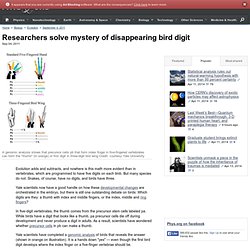
But many species do not. Snakes, of course, have no digits, and birds have three. Yale scientists now have a good handle on how these developmental changes are orchestrated in the embryo, but there is still one outstanding debate on birds: Which digits are they: a thumb with index and middle fingers, or the index, middle and ring fingers? In five-digit vertebrates, the thumb comes from the precursor stem cells labeled pa. While birds have a digit that looks like a thumb, pa precursor cells die off during development and never produce a digit in adults.
Miss USA 2011 - 51 Delegates Interview (Q2 - Evolution taught in school) Microspectroscopic Evidence of Cretaceous Bone Proteins. Low concentrations of the structural protein collagen have recently been reported in dinosaur fossils based primarily on mass spectrometric analyses of whole bone extracts.
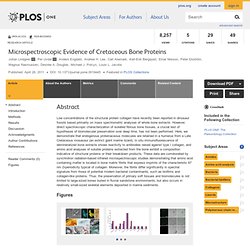
However, direct spectroscopic characterization of isolated fibrous bone tissues, a crucial test of hypotheses of biomolecular preservation over deep time, has not been performed. Here, we demonstrate that endogenous proteinaceous molecules are retained in a humerus from a Late Cretaceous mosasaur (an extinct giant marine lizard). In situ immunofluorescence of demineralized bone extracts shows reactivity to antibodies raised against type I collagen, and amino acid analyses of soluble proteins extracted from the bone exhibit a composition indicative of structural proteins or their breakdown products. Figures. Antievolution bill in New Mexico dies. Marsupial Tree Frog Evolved to Regain Teeth That Ancestors Lost.
Evolution Made Us All. Not just another genome. What's Up, Doc? Porto-Lisboa em 4600 milhões de anos. Devido ao meu passado e formação como professor, as analogias têm em mim, como noutros, um fascínio e utilidade únicas.
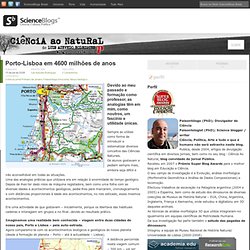
Sempre as utilizei como forma de introduzir e sistematizar diversos conceitos das Ciências Naturais.Os alunos gostavam e pediam sempre mais, embora seja difícil e não aconselhável em todas as situações.Uma das analogias práticas que utilizava era em relação à enormidade do tempo geológico. Depois de lhes ter dado rolos de máquina registadora, bem como uma folha com as diversas idades e acontecimentos geológicos, pedia-lhes para marcarem, cronologicamente e com distâncias proporcionais à idade dos acontecimentos, no rolo esticado, esses mesmos acontecimentos. Era uma actividade de que gostavam – inicialmente, porque os libertava das habituais cadeiras e interagiam em grupos e no final…devido ao resultado prático.
A saída dos Carvalhos é o equivalente na nossa viagem à formação da Lua (4500 MA). Chimpanzee and human Y chromosomes are remarkably divergent in s. Harvard Magazine Nov-Dec 2007. When Harvard curator of fossil insects Frank M.
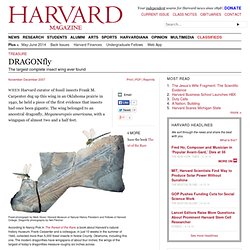
Carpenter dug up this wing in an Oklahoma prairie in 1940, he held a piece of the first evidence that insects had once been gigantic. The wing belonged to an ancestral dragonfly, Meganeuropsis americana, with a wingspan of almost two and a half feet. Fossil photograph by Mark Sloan/ Harvard Museum of Natural History President and Fellows of Harvard College; Dragonfly photographs by Neil Fletcher According to Nancy Pick in The Rarest of the Rare, a book about Harvard’s natural history museum, Frank Carpenter and a colleague, in just 10 weeks in the summer of 1940, collected more than 5,000 fossil insects in Noble County, Oklahoma, including this one.
The modern dragonflies have wingspans of about four inches; the wings of the largest of today’s dragonflies measure roughly six inches across. View the full-size image Meganeuropsis is alive and earning a living in popular culture. Diatoms key to evolution of whales. A new study by scientists has determined that a type of algae called diatoms have been key to the evolution of the diversity of whales.
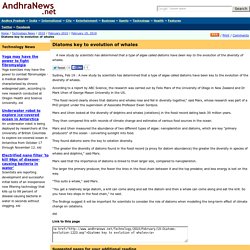
Sydney, Feb 19 : A new study by scientists has determined that a type of algae called diatoms have been key to the evolution of the diversity of whales. According to a report by ABC Science, the research was carried out by Felix Marx of the University of Otago in New Zealand and Dr Mark Uhen of George Mason University in the US. "The fossil record clearly shows that diatoms and whales rose and fell in diversity together," said Marx, whose research was part of a PhD project under the supervision of Associate Professor Ewan Sordyce.
Evolution: like any other science it is predictable. - novoseek.